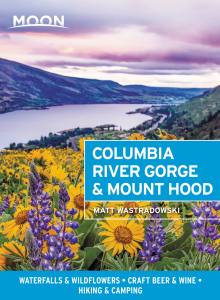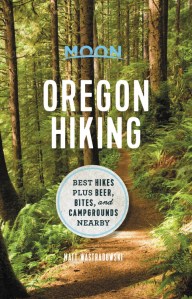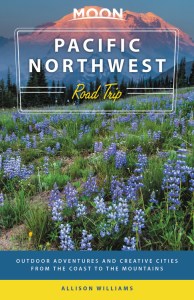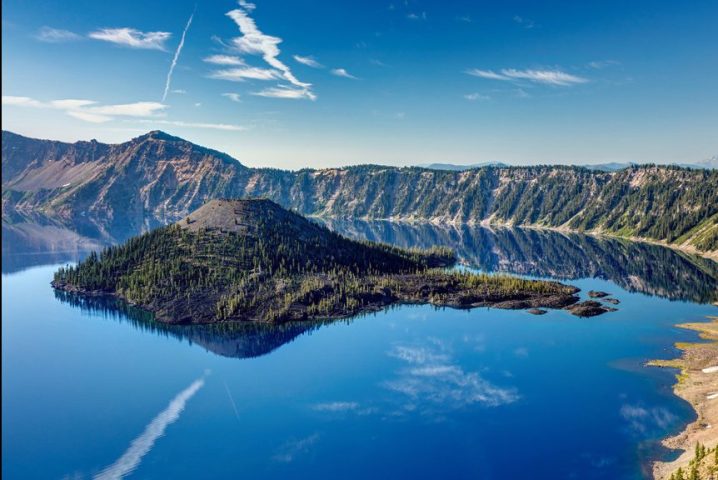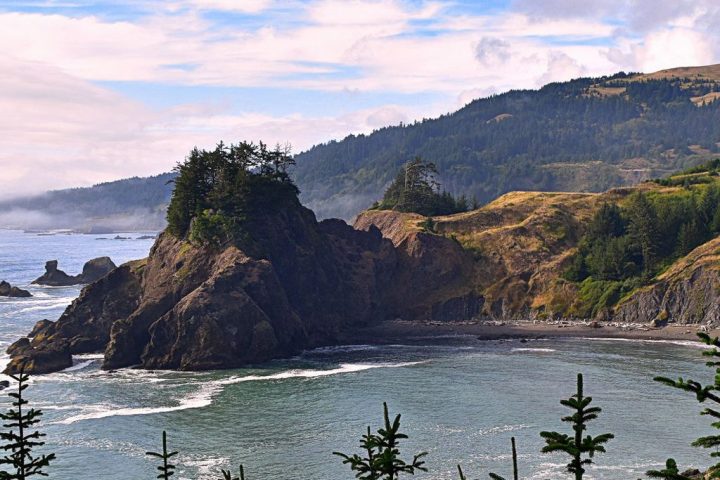5 Reasons Why You Should Visit the Columbia River Gorge and Mount Hood

In the late 1970s, the calls to protect the Columbia River Gorge were growing louder. Portland’s population was growing steadily, an interstate bridge spanning the Columbia River was constructed near Portland’s east side, and the city’s suburbs were inching eastward, knocking on the doorstep of the Columbia River Gorge—an expansive river canyon that measures 80 miles long and up to 4,000 feet deep.
Portlanders worried that the Gorge’s outdoor recreation—hiking, sightseeing, mountain biking, and more—would be lost to history with unchecked development and industrial growth. Fortunately, the Columbia River Gorge National Scenic Area was created in 1986, protecting the region for generations to come.
Today, the Gorge—along with Mount Hood, which sits just 25 miles to the south and is Oregon’s tallest peak—is one of the Pacific Northwest’s most fruitful outdoor destinations. Popular activities include hiking, mountain biking, skiing, and sightseeing—as well as exploring the Hood River Fruit Loop, a collection of roughly two dozen agricultural stops between Hood River and Mount Hood.
Want to explore this scenic region? Here are five reasons why you should make the Columbia River Gorge your next trip:
1. The Gorge hosts the highest concentration of waterfalls in North America
The Sierra Club has declared that the Columbia Gorge National Scenic Area is home to the highest concentration of waterfalls in North America: more than 90 in all. That distinction has earned the region—most notably, a 21-mile stretch of the Historic Columbia River Highway—the nicknames “Waterfall Alley” or “Waterfall Corridor.”
You won’t see all 90 waterfalls—some are tucked away in quiet canyons—but several are visible from roadside viewpoints and myriad hiking trails. Here’s a rundown of some of my favorite waterfalls:
Multnomah Falls
Perhaps the most popular natural attraction anywhere in Oregon, the 620-foot Multnomah Falls plunges in two cascades, with a pedestrian bridge offering majestic views near its base. The waterfall, one of Oregon’s tallest, is a popular year-round attraction—but try to make time for an autumn outing, when crowds are smaller, rainfall fills the plume, and colorful fall foliage puts on dazzling displays. A paved path ascends to the top of Multnomah Falls, part of a longer (six-mile) loop that showcases a half-dozen waterfalls in all. (Learn more in Moon Oregon Hiking.) Note that Multnomah Falls may require advance reservations when visiting in spring and summer; check with the U.S. Forest Service’s website for Multnomah Falls before heading out to see whether a timed-entry ticket may be required.
Latourell Falls

The 200-foot Latourell Falls can be viewed from a roadside viewpoint (following a short, flat hike) or as part of a longer, 3-mile round-trip hike that ascends nearly 900 feet. The waterfall is among the most scenic anywhere in the Gorge, falling in an amphitheater of lichen-covered columnar basalt. Doing the longer loop hike includes a stop at Upper Latourell Falls.
Horsetail Falls
Finally—a waterfall that doesn’t demand much of a hike. Visible right off the historic highway, Horsetail Falls plummets into a pool next to the road. You’ll find a viewing platform and picnic area at the base of the falls; if you need to stretch your legs, consider an 0.8-mile round-trip trail that leaves from the viewpoint and ascends to the smaller Upper Horsetail Falls—also known as Ponytail Falls.
2. Hood River is home to four seasons of outdoor recreation
When someone in Hood River asks what you’re up to this weekend, they’re not really asking whether you’re running to the bank or shopping for groceries; they’re asking where in the outdoors you’re heading.
That’s because Hood River is home to a wide range of outdoor recreation, both in and around town. No matter the time of year, there’s plenty to do without going far. Here’s a season-by-season breakdown of what outdoor fun you’ll find around Hood River.
Spring
Springtime wildflowers abound all around Hood River; hiking trails at Tom McCall Point, Coyote Wall and Catherine Creek (both just across the Columbia River), and the Historic Columbia River Highway State Trail (with a trailhead just south of downtown) all feature dazzling displays between March and May each year. Watch for stalks of purple lupine and yellow arrowleaf balsamroot.
Summer
In Hood River, the cool, damp air from the western side of the Cascades meets the hot, dry air of the eastern side—creating a kind of wind tunnel that has helped the city become known as the “Windsurfing Capital of the World.” Between June and September, windsurfers and kiteboarders flock to the Columbia River, with several outfitters offering lessons and rentals around town.
Ready to start planning your adventure? This is the one and only guide to the region:
Fall
Hood River’s mountain biking scene can be summed up in two words: Post Canyon. The versatile Post Canyon Trail System, just past the western edge of Hood River, is a network of 38 trails comprising nearly 60 miles and offering everything from flowing single-tracks to steep climbs to tight, S-shaped curves. The trails can get hot and dusty in the heart of summer, making fall an ideal time to explore Post Canyon. Several bike shops around town offer daily rentals and shuttle services.
Winter
You won’t find a ton of outdoor recreation in Hood River proper—but Mount Hood (and its five ski resorts) are no more than an hour away. Given that Timberline Lodge is the only one of those resorts to offer overnight accommodations, Hood River makes an ideal basecamp for a weekend on the mountain.
3. Mosier and the eastern Columbia River Gorge have plenty to show off
Hood River is undeniably the sun around which the rest of the Columbia River Gorge orbits—but just a few minutes east sits the small community of Mosier, home to a surprisingly wide range of outdoor opportunities.
Historic Columbia River Highway State Trail
A decommissioned section of the Historic Columbia River Highway between Hood River and Mosier has been repurposed as a walking and cycling path—and is now part of the larger Historic Columbia River Highway State Trail. The nine-mile (round-trip) paved path cuts through the much-photographed Mosier Twin Tunnels (just 0.75 mile from the trailhead in Mosier) while showcasing a gradual change in scenery, from the green forests near Hood River to the more arid climate close to Mosier. Bicycle rentals are available in Hood River, while the eastern trailhead in Mosier offers easy access to the tunnels.

Mosier Plateau trail
Starting from the heart of Mosier, the short (3.7-mile round-trip) hike to Mosier Plateau has a lot to love, all year long. The trail passes a waterfall, ascends a grassy hillside (covered with colorful wildflowers each spring), and—best of all—arrives at a viewpoint that peers directly into the heart of the Gorge. If you bring a flashlight for the return trip, this makes an idyllic spot to watch the sunset.
Historic Columbia River Highway and Rowena Crest
Taking the Historic Columbia River Highway east of Mosier, you quickly see why this is one of the most popular stretches of road anywhere on the highway: Dramatic curves offer exciting twists and turns, steep ascents reward drivers with dramatic Gorge views, and the turnoff at Rowena Crest and Tom McCall Point provide some of the most-photographed highlights anywhere in the region. At the east end of the Rowena Crest viewpoint, for instance, visitors can peer to the south for striking views of a winding S-curve in the highway. And the Tom McCall Preserve at Rowena (open March-October) hosts a pair of hikes (totaling about 6.5 miles round-trip) that offer dramatic wildflower views in spring and sweeping Cascade Range views in summer and fall.
4. The Hood River Fruit Loop is full of flavorful fun
Roughly two dozen stops comprise the Hood River Fruit Loop, a self-guided tour route that heads south from Hood River and into the heart of the Hood River Valley. Along the way, you’ll find farms, markets, cider makers, vintners, and more who work all year long to bring a taste of the Hood River Valley to visitors from around the world. These are a few of my favorite stops along the route:
The Gorge White House

For a little of everything that makes the Fruit Loop so fun, stop by The Gorge White House. The family-run farm offers U-pick opportunities (ranging from peonies in spring to berries in summer), crafts its own cider and wine, and dishes fresh fare from an on-site food cart (usually spotlighting farm-grown ingredients).
Wy’East Vineyards
The Columbia River Gorge is renowned for growing some of the region’s best-loved wine grapes, and the family-owned Wy’East Vineyards offers the chance to sample a wide range of locally made wines. If the sun’s out, shoot for a seat on the tasting room’s spacious patio, which affords sweeping views of Mount Hood.
Packer Orchards & Bakery
Need a treat for the road? Stop by Packer Orchards & Bakery for fresh fruit, house-baked goods, homemade jams and jellies, ice cream, milkshakes, and other goodies. The cookies, in particular, are soft and chewy—and the marionberry cinnamon roll (a local delicacy) is a decadent dessert.
Finally, a friendly heads-up: Many of the stops along the Fruit Loop close in winter; those that remain open, may do so with reduced hours or reduced services. Check with your preferred destinations before heading out between (roughly) October and March—just to be safe.
5. Mount Hood boasts outdoor opportunities all year long
No matter the time of year, you’ll find plenty to love on the slopes of Mount Hood—Oregon’s tallest peak. Here are a few of my favorite activities:
Hike to Little Crater Lake
It’s not quite as famous as our other Crater Lake, but the wheelchair-accessible (0.3-mile round-trip) hike to Little Crater Lake makes for a fun summertime jaunt. The spring-fed lake hovers around 34ºF year-round and is noted for its remarkable clarity.
Visit Trillium Lake

In late spring, summer, and early fall, Trillium Lake is one of the most popular outdoor destinations in Oregon—thanks to sweeping views of Mount Hood immediately to the north. The lake hosts a sprawling campground just a short walk from the lakeshore, numerous picnic tables for enjoying lunch, a mostly flat hiking trail around the lake’s banks, and watercraft rentals (single kayaks, tandem kayaks, and stand-up paddleboards) via Mt. Hood Outfitters. In winter, the lake transforms into a popular cross-country skiing and snowshoeing destination. (If visiting in summer, be sure to show up early; Trillium Lake’s parking areas can fill by 10 a.m. on summer weekdays.)
Ski the slopes of Mount Hood
In all, five resorts cover the slopes of Mount Hood, from beginner-friendly, mom-and-pop outfits to some of the biggest names in Oregon. Between December and March, the resorts stay packed with skiers, snowboarders, and tubers enticed by a wide range of terrain, picturesque views, and fresh powder.
Matt Wastradowski is a travel and outdoors writer based in Bend, Oregon. Whether on assignment or just for fun, chances are good he’s doing something that deepens his passion and enthusiasm for the Beaver State and the broader Pacific Northwest. In recent years, he has visited nearly 150 breweries and cideries, hiked hundreds of miles, and driven roughly 20,000 miles around Oregon. He’s camped in tents, yurts, and fire lookouts. And he’s spent countless hours exploring seemingly every backcountry road this state has to offer, often with no bars on his iPhone. In addition to Moon Columbia River Gorge & Mount Hood, he is also the author of Moon Oregon Hiking and co-author of Moon Pacific Northwest Hiking.
Explore more guides to the Pacific Northwest:
By clicking ‘Sign Up,’ I acknowledge that I have read and agree to Hachette Book Group’s Privacy Policy and Terms of Use
what to read next:
